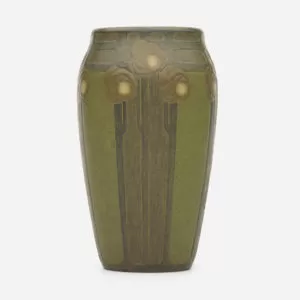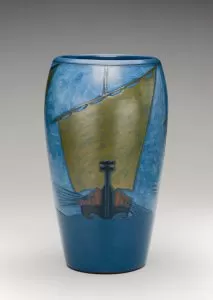The Mystique of Marblehead
by Kate Nixon
To any random person, June 20th was simply the starting date of a more socially-distant summer season. For Arts and Crafts enthusiasts and collectors active in the online collecting community, it was a weekend of opportunities for interactive learning over Zoom, remote museum tours, and for those in the know, a day for placing bids online for rare and important pottery at Rago Arts and Auctions’ American Art Pottery Auction.

An exceptional and rare Marblehead vase sold for more than four times its high estimate at Rago’s American Art Pottery auction, selling for $150,000! Photo by Rago Arts and Auction Center.
As expected, a small number of important George E. Ohr vases and ceramic works sold very well during this auction, one large vase of Ohr’s sold for $62,500. However, the high seller of the auction was a rare and exceptional vase from Arthur Hennessey and Sarah Tutt for Marblehead Pottery; the glazen earthenware vase featuring clearly carved conventionalized flowers and one of only four known examples of this kind sold for $150,000, smashing the previously held record for work by Marblehead of $121,000 – by that same vase.
A simple search for sold lots of Marblehead Pottery on liveauctioneers.com shows the first entry seen as a table lamp – with a marked base and a green glass globe – sold for $5,000: its high estimate was $500. As it turns out, that lot was deaccessioned from a collection from actor Bruce Willis. Another search showed a green-glazed Marblehead vase sold at Bonham’s auctions in 2014 – during the sale of Bruce Willis’ collection – for $40,000. This particular vase was designed by Arthur Irwin Hennesey and decorated by Sarah Tutt – the same team behind the winning $150,000 vase. Another telling sign of the duo is a mark of the initials “HT” stamped on the bottom of a Hennessey and Tutt vase.
From its origins at the turn of the century, the simple and well-designed shapes combined with a nature-themed decor was a good match for the burgeoning Arts and Crafts movement and by 1908, the small company led by manager Arthur E. Baggs was producing almost 200 works per week. The growing company hired a small staff of full time designers – Hennessey and Tutt among them – and by 1915, Marblehead Pottery had grown far past the original vision of providing medical patients with a form of occupational therapy.

Artisans making their works at Marblehead Pottery. Image from the 1905 publication American Homes And Gardens, page 303. Photo courtesy of Wikimedia Commons.
As co-authors David Rago and Bruce Johnson explained in The Official Price Guide to American Arts and Crafts, the forms and décor of each work was unique and endearing to the public. “The simple forms and soft matte-glazed decorations appealed to an Arts and Crafts-conscious public. While popular designs were often repeated, vases and bowls continued to be hand-thrown and individually decorated by the artist, ensuring their clients that no two items — with the exception of tiles and molded bookends — could ever be identical.” The works themselves were often made of rich and red clay. Designs were Indian and nautically-themed early on, transitioning into insects, flora, birds, seashells and sailing ships, the latter was placed as part of Marblehead’s shopmark.

The shopmark of Marblehead Pottery.
Perhaps the element that distinguished the growing company from most of its competitors was the flat abstract patterns of Marblehead works and in 1987, Dr. Martin Eidelberg observed an evolution in patterns. “Typical of the new sparse mode, Walrath and Marblehead shrank the design elements into linear, vertical, or horizontal patterns and vastly increased the negative spaces of the ground, There was only one step left to take, and Baggs took it. He pushed past conventionalization into non-representation design through the use of geometric motifs.” Then there was the glaze; the popular vellum matte glaze, the special glaze developed by Baggs and company brightly showed color, design, and surface all at once making for a glorious example of quality pottery. In fact, the forms and the glazes developed through Marblehead pottery commanded respect from all over the country.
So what makes Marblehead pottery so desirable to collectors in current day? Those same forms and glazes in works passed down through generations are reminders of the legacy of Baggs, the brilliance of those early designers, and examples of the beauty of form and design in art pottery. “It was really Arthur Baggs talent as a potter, Arthur Hennessey’s designs, and Sarah Tutt’s skill as a decorator that makes this pottery special. Make no mistake, these pieces were not made by amateurs, patients or otherwise,” says Jim Messineo, owner of JMW Gallery in Cambridge, MA. “The fact the Newark Museum purchased one in 1910 and that there are maybe a half dozen other examples out there means there’s not enough to go around.” Even the undecorated ware produced were considered high quality and high value for what they sell for, which often times is under the $500 mark.

Earthenware Marblehead Pottery vase (ca 1915–1920) A gift from Robert A. Ellison Jr. to the Metropolitan Museum of Art. (2017) Photo courtesy of Wikimedia Commons and the Metropolitan Museum of Art
It made perfect sense then that the well-preserved and exceptional Marblehead vase at Rago’s auction was the high seller. Not only did the piece have a reputation for being featured in several publications as a prime example of Marblehead, but the design of the roses featured influenced by the iconic Mackintosh Rose made the work a quintessential one of its field. “That vase is one of the iconic pieces of American Art Pottery,” said Messineo. “This example was a beautiful synthesis of deep carving, beautiful form, and good contrast, all important aspects in assessing the best art pottery and supply and demand is what makes for the high price.” Form, function, and design are all high quality here, providing collectors all over the country with a fantastic work for its value and keeping the legacy of Arthur Baggs and Marblehead Pottery going for generations to come.
